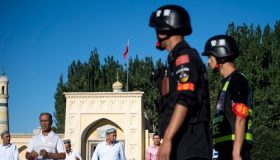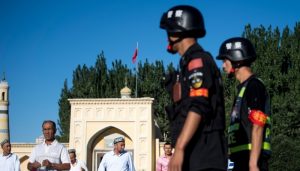Xinjiang: Economic Realities Behind Civil Strife

Stratfor, 23 August 2017
 By Douglas Green – A radical shift in domestic policy in and regarding China’s northwestern autonomous region of Xinjiang, replacing communal coexistence between Chinese “colonials” and the indigenous Uyghur population, is claimed by central authorities in Beijing to be aimed at lifting development and living standards of the entire population. This could negatively affect the mood among exiled Uyghur communities in neighboring states, and drive increasing parts of the Uyghur nation straight into the arms of sinister extremist organizations such as Daesh, Al-Qaeda and Taliban. Xinjiang has been a place of multiple headaches for the Chinese Government and here security and economics should complement rather than contradict each other and the current pressures of varying sources leave plenty of room for improvement.
By Douglas Green – A radical shift in domestic policy in and regarding China’s northwestern autonomous region of Xinjiang, replacing communal coexistence between Chinese “colonials” and the indigenous Uyghur population, is claimed by central authorities in Beijing to be aimed at lifting development and living standards of the entire population. This could negatively affect the mood among exiled Uyghur communities in neighboring states, and drive increasing parts of the Uyghur nation straight into the arms of sinister extremist organizations such as Daesh, Al-Qaeda and Taliban. Xinjiang has been a place of multiple headaches for the Chinese Government and here security and economics should complement rather than contradict each other and the current pressures of varying sources leave plenty of room for improvement.
Unpopular restrictions
China has reportedly imposed a ban on the Uyghur language, which belongs to the Turkic linguistic “family”, in education and official communication. In addition, it has announced an end to the Uyghur privilege in birth control planning: starting July 28 this year, all urban couples in the region disregarding their ethnic origin have been allowed to have two children and rural couples can have three. This new restriction follows the one in November 2016 when all residents of Xinjiang were requested to hand over their passports to police and to apply for permission if they wish to leave the country, all this restricting movement even to visit relatives in the neighboring countries.
Impoverished and poorly developed
Though the measure covers all of China, it mainly hits the vast and thinly-populated province of Xinjiang, conquered in the middle of the XVII Century but claimed by Russia in the late XIX Century and partly occupied by it until Lenin gave it back to China shortly after having seized power. Here, a narrow majority of Uyghurs live together with a large minority of Han Chinese and smaller communities of Kazakh, Kyrgyz, Dungan and other ethnic communities.
China’s policy appears to be ambiguous. On one hand, it has invested, and keeps investing, large sums of money into industry and infrastructure in Xinjiang, with the aim to improve living standards in the still impoverished and poorly developed land. Central authorities claim that the abolishment of the bilingual regime is in line with that goal. It is claimed that younger Uyghurs prefer to communicate in Mandarin Chinese, since they feel that this “opens doors” to better education, better careers and a better life. Especially among urbanized Uyghurs, there may be an element of truth in this: parallel trends can be seen in better-off circles in former Soviet republics regarding the use of Russian, seen as a vehicle to become “part of the grand world”.
Laborious and dangerous
On the other end of the line, there are the rural Uyghurs, isolated and dependent on primitive forms of coal mining and cotton farming. Both of them are dependent on hand labour under very harsh natural conditions. As late as the 1990s, European visitors still reported about thousands of families living uphill in southern Xinjiang under primitive circumstances in makeshift homes in hand-dug caves while making a meagre living on coal. But apart from laborious, the work is dangerous as well because of the notorious coal fires. The underground reservoirs bear temperatures of up to 2,000 degrees Celsius, and once touched upon and brought in contact with the atmosphere they burst out in an infernal blaze, reducing the entire structure and its surroundings to boiling liquid, ashes and smoke. Yet, once the remains are cooled, mineral farmers manage to win salmiac (ammonium chloride) from the upper layers, which they sell to the Chinese chemical industry.
Subsidized products
Prices for coal and its byproducts have been subsidized by the Chinese government for a long time. Now, the subsidies are being cut down and over a hundred small mines have been shut down this year, to be followed by hundreds more. This fits in to China’s plan to do away with coal altogether, put an end to the smog problem that plagues the bulk of the country, and give young generations hope for a “green” future.
What is true for coal is true for cotton – a water-thirsty crop which drains ever dwindling freshwater supplies, due to a combination of over-irrigation and climatic warming.
Due to national legislation which forbids corporate landownership, cotton farmers in Xinjiang are condemned to undercapitalized petty enterprise. Instead, like with coal, the government sticks to sales subsidies to grant rural families bread on the shelf. A cap on imported cotton should force industries to keep buying at non-competitive prices.
“A tonne of Xinjiang cotton is priced at 15,940 yuan, while imported US cotton of comparable quality is 13,800 yuan. In May, the difference was around 1,000 yuan, and by the end of June it was more than 2,000 yuan,” a recent report in the Singapore-based newspaper Asia Times reads. “China’s restive Xinjiang Uyghur Autonomous Region is the national leader in cotton production. In 2016, Xinjiang produced 3.59 million tonnes of cotton or 67% of the national total. Cotton constitutes more than half of Xinjiang’s agricultural output value. Half of the farmers in Xinjiang grow cotton, which makes up 35% of their annual net income.”
Security and economics
It is the pressure on outdated market conditions, dictated by China’s contradictory policies, that turns the economic problem into a political one, and thereby into a major security risk. Misery is the favourite and indeed most effective vehicle of destructive forces such as Daesh to subdue populations and expand territory, and after ongoing setbacks in the Near East Central Asia tops the list of replacement priorities. Xinjiang finds itself right at the heart of it all. Its northernmost frontier consists of a short border with the Russian Federation, flanked by longer ones with Mongolia to its east and Kazakhstan to its west. To the latter’s south, there is a more volatile and ill-controlled frontier with Kyrgyzstan, followed by a similar one with Tajikistan, an extremely volatile short border strip with Afghanistan, and to its south a similarly troublesome frontier with the disputed Indo-Pakistani province of Kashmir. The circle is closed by a long borderline with Tibet, and a shorter one with China proper.
Reported by Douglas Green for Stratfor
https://worldview.stratfor.com/article/xinjiang-economic-realities-behind-civil-strife

